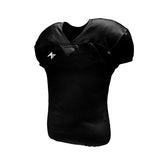Basketball, with its fast-paced action and strategic depth, captivates millions around the globe. Yet, to truly appreciate the game, understanding its rules is essential. This in-depth exploration of basketball rules aims to demystify the complexities, clarifying everything from scoring to fouls and strategies.
Whether you're a player, coach, or fan, decoding these rules will enhance your enjoyment and insight into this thrilling sport.
Unlocking the Secrets of Basketball Rules - A Comprehensive Guide
The Basics of Basketball
Basketball is played between two teams, each with five players. The aim is to score points by shooting the ball through the opponent's hoop, elevated 10 feet off the ground. The team with the most points at the end wins.
The Court and Equipment
A standard basketball court is rectangular, measuring 94 feet by 50 feet. The three-point line, free-throw line, and the paint (or key) are key areas. The ball is made of leather or synthetic material, with a circumference of about 29.5 inches for men's games and 28.5 inches for women's games.
Game Duration
A professional basketball game consists of four quarters. Each quarter lasts 12 minutes in the NBA and 10 minutes in FIBA games. If the score is tied at the end of regulation time, the game goes into overtime periods, usually five minutes each, until a winner is determined.
Scoring
Points are awarded based on where a shot is taken:
- Two-Point Field Goal: Any shot made from inside the three-point line.
- Three-Point Field Goal: Any shot made from beyond the three-point line.
- Free Throw: Worth one point, awarded after certain fouls, and taken from the free-throw line.
Fouls and Violations
Understanding fouls and violations is crucial for fair play.
Personal Fouls
A personal foul involves illegal physical contact with an opponent. Common personal fouls include:
- Blocking: Illegal contact by a defender when trying to impede an offensive player.
- Charging: When an offensive player runs into a stationary defender.
- Holding: Using hands to impede the movement of an opponent.
Technical Fouls
Technical fouls are awarded for unsportsmanlike conduct or violations by team members on the bench. These can result in free throws for the opposing team.
Violations
Violations are breaches of the game's rules but do not involve physical contact. Key violations include:
- Traveling: Moving more than two steps without dribbling the ball.
- Double Dribble: Dribbling the ball, stopping, and then starting again.
- Shot Clock Violation: Failing to attempt a shot within 24 seconds (NBA) or 14 seconds (offensive rebound).
Possession and Dribbling
The game starts with a jump ball, where the referee tosses the ball into the air, and players from each team try to gain possession. Dribbling is the act of bouncing the ball while moving. Fundamental rules around dribbling include:
- Carrying: Placing the hand under the ball and then continuing to dribble.
- Palming: Similar to carrying but involves a more pronounced action of turning the wrist.
The Role of Referees
Referees enforce the rules and ensure fair play. They call fouls and violations and make crucial decisions throughout the game. Typically, there are three referees in a professional game.
Defensive and Offensive Strategies
Teams use various strategies to outplay their opponents.
Offensive Strategies
- Pick and Roll: A player sets a screen (pick) for a teammate handling the ball and then moves (rolls) toward the basket.
- Isolation: Clearing out one side of the court to let players take on their defender one-on-one.
Defensive Strategies
- Man-to-Man Defense: Each defender is responsible for guarding a specific player.
- Zone Defense: Defenders cover specific court areas rather than individual players.
Timeouts and Substitutions
Coaches use timeouts to strategize and give players rest. Each team has a limited number of timeouts per game. Substitutions allow fresh players to enter the game, keeping the team dynamic and energetic.
Endgame Scenarios
In close games, endgame strategies become crucial. Teams might intentionally foul to stop the clock and gain possession, and coaches draw up specific plays to create scoring opportunities.
Understanding Key Terminology
Familiarity with basketball terminology enhances the viewing experience. Key terms include:
- Assist A pass leading directly to a basket.
- Rebound: Gaining possession after a missed shot.
- Steal: Legally taking the ball away from an opponent.
Conclusion
Decoding basketball rules is essential for appreciating the sport. From the basics of scoring to the intricacies of fouls and strategies, each rule contributes to the game's excitement and fairness. Whether you're a player, coach, or fan, understanding these rules enriches your basketball experience. You can enjoy the game with greater insight and enthusiasm by grasping the essentials.




